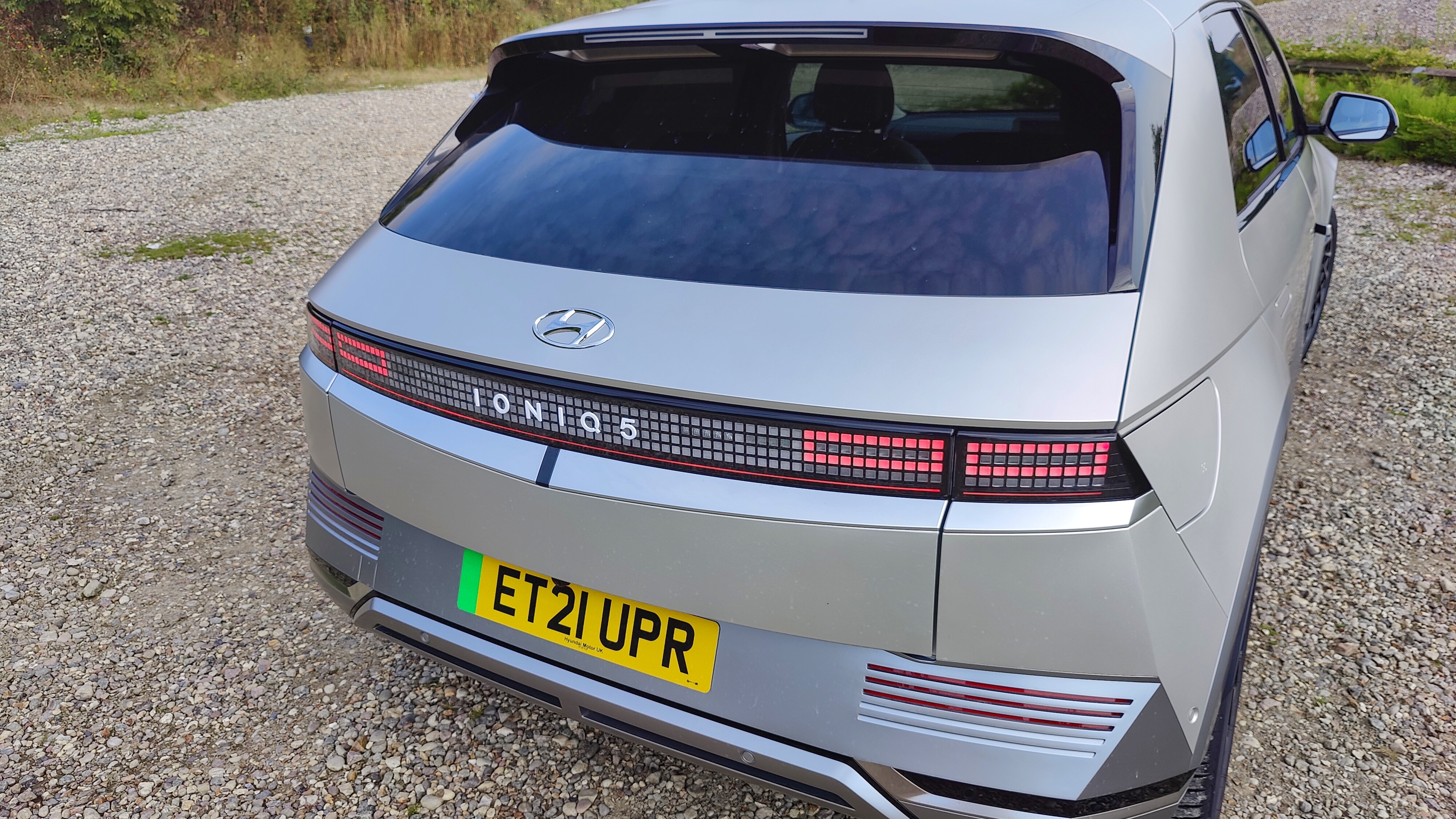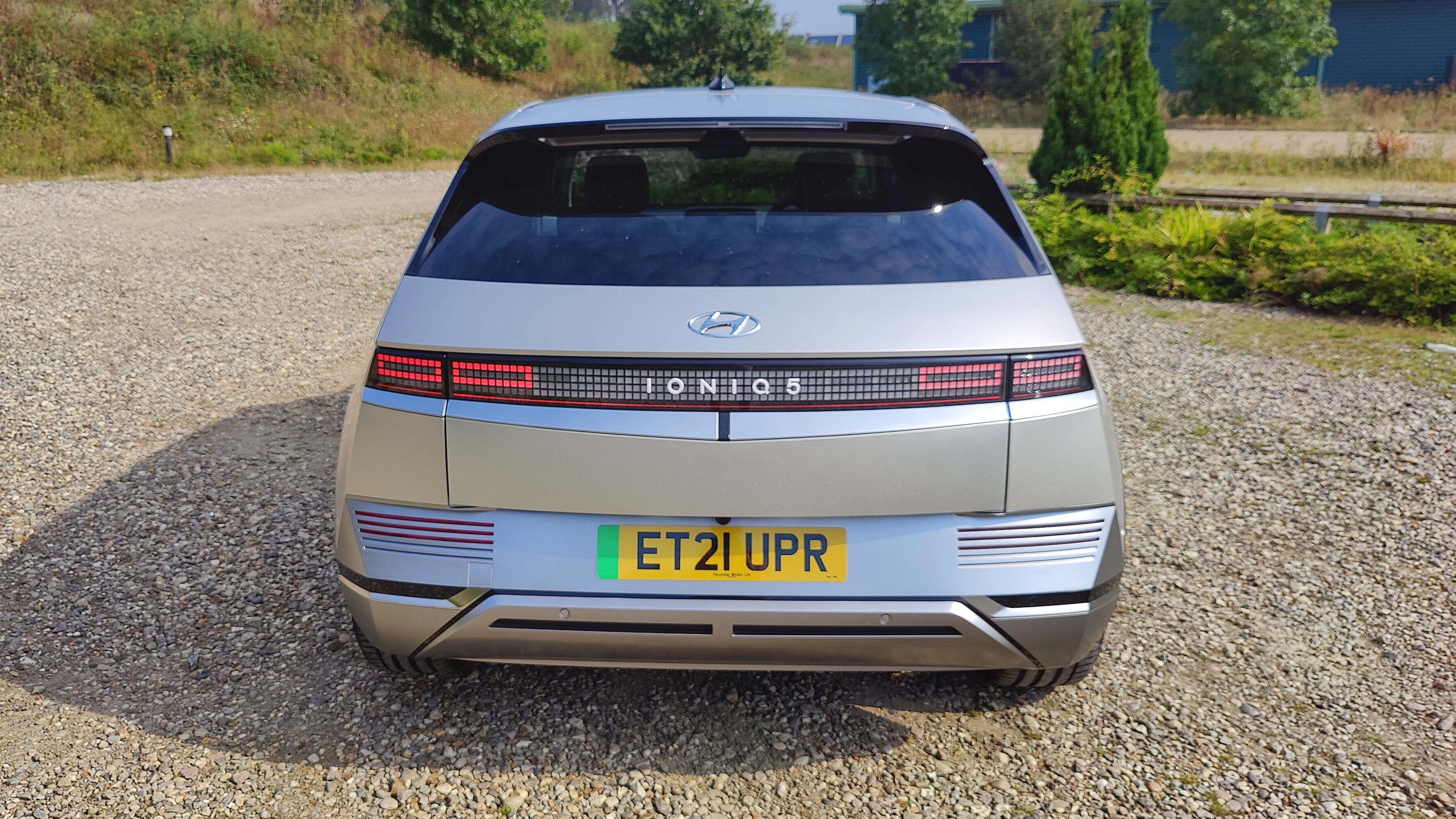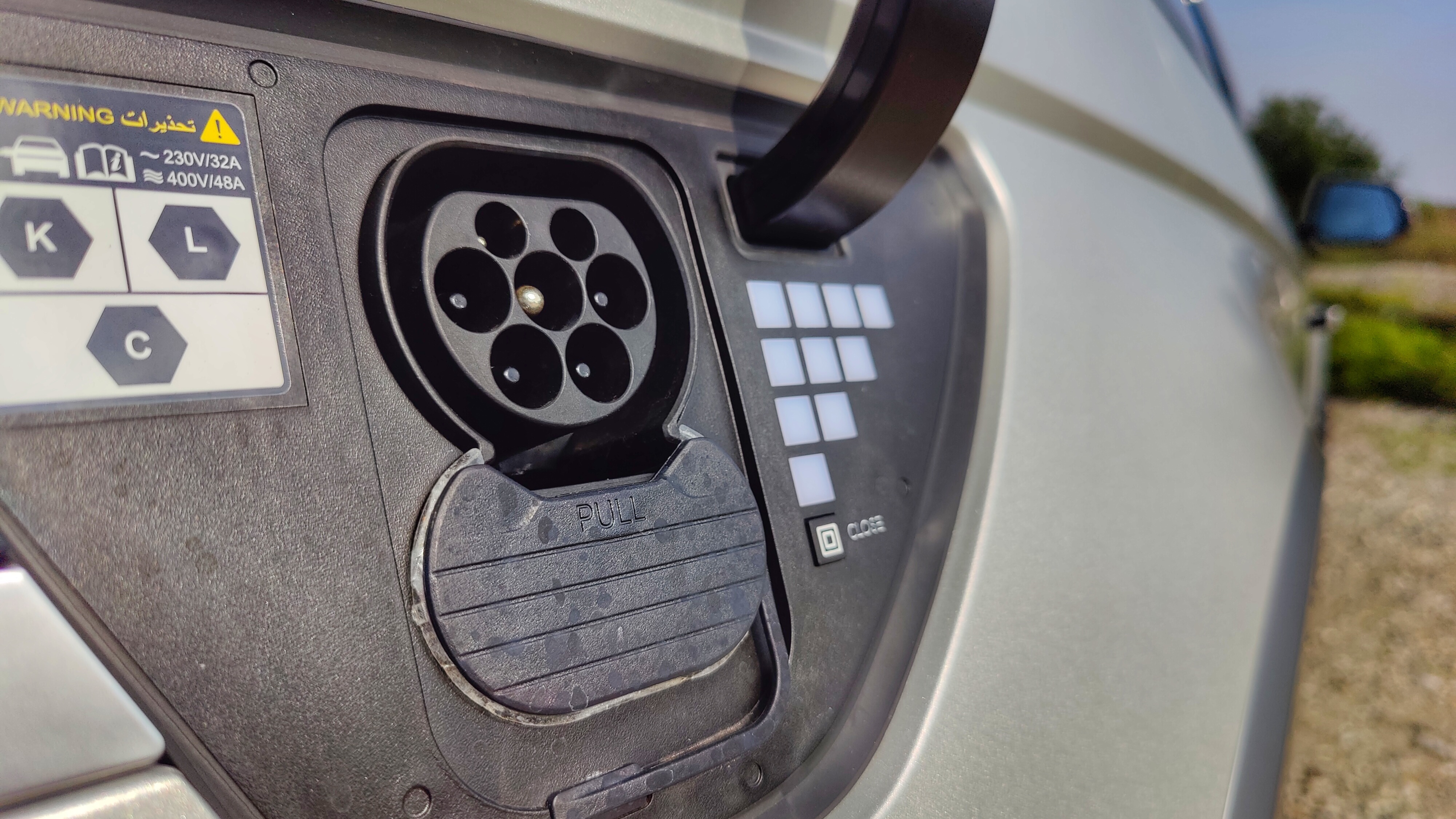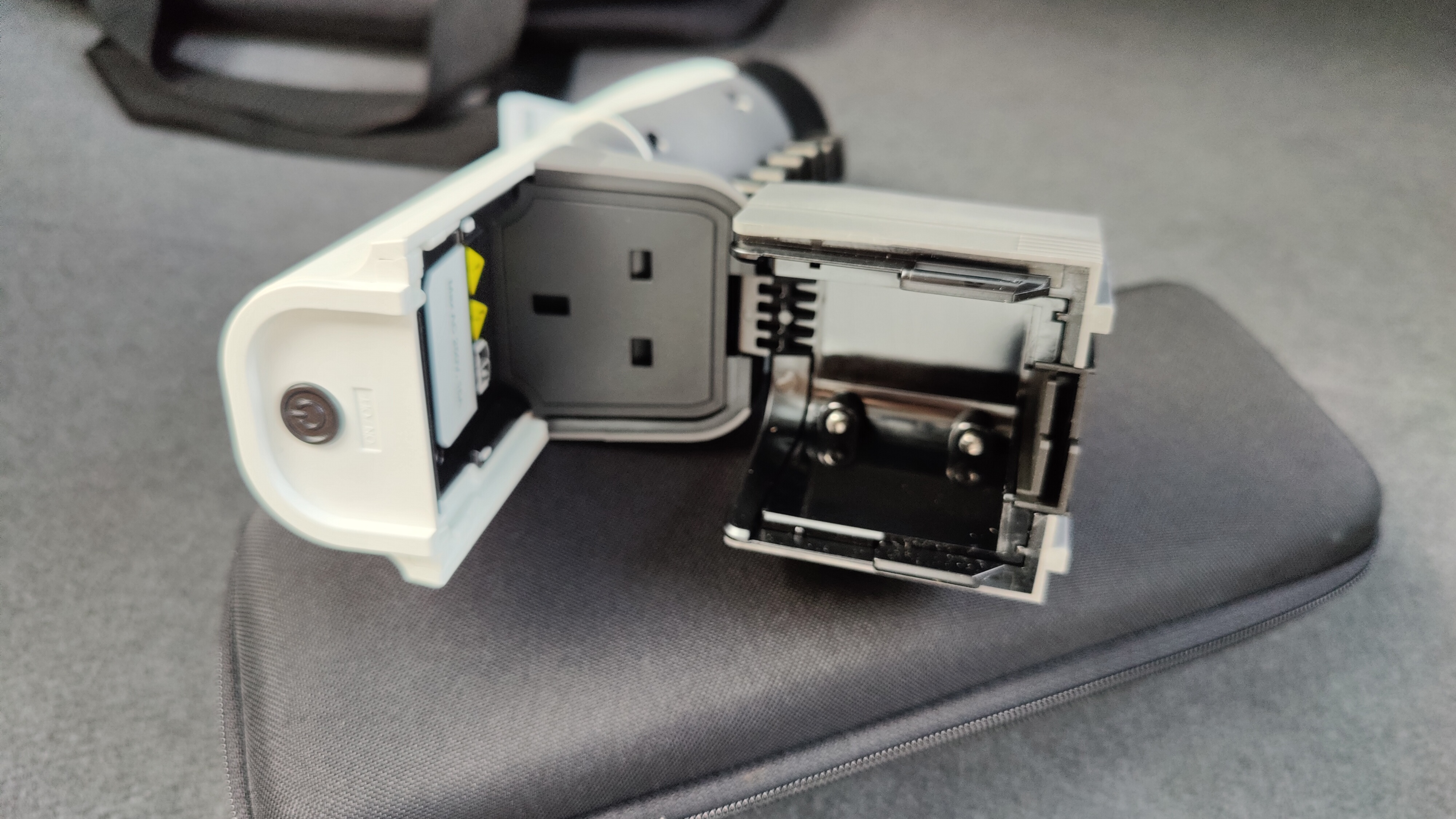Hyundai Ioniq 5 review: a superb electric car that can turn heads
An attractive proposition for a range of buyers

Two minute review
The Hyundai Ioniq 5 is one of the best electric cars currently available. It offers up a wide feature set, solid range, plenty of space, eye-catching design and a comfortable ride.
It makes this electric SUV an attractive proposition for a range of buyers, from the EV enthusiast through to families.
The angular bodywork with pixel-shaped highlights give the Ioniq 5 a unique look that stands out from other EVs. The front and rear lights are especially aesthetically pleasing.
Climb inside and you’re greeted with a wonderfully spacious cabin. It may not be the most premium in terms of look and feel, but it’s comfortable and functional.
The sliding centre console provides storage, cup holders and no fewer than four USB ports, plus a wireless charging pad for your phone.
A couple of bezel-heavy 12.3-inch touchscreens sit atop the dashboard, with the central display providing access to the infotainment system. It works well, but it can be a little slow to load and the sat nav isn’t the best we’ve used.
However, there is support for Android Auto and Apple CarPlay, which means you’ll be able to access superior mapping options via your smartphone.
Sign up for breaking news, reviews, opinion, top tech deals, and more.

Hyundai quotes up to 300 miles WLTP of range for the Ioniq 5, and while you’re not going to get that with real-world use, over 250 miles is achievable. There’s also the added bonus of 350kW charging support, which can get you to 80% in 18 minutes.
A selection of driving aids will be handy, including lane assist and adaptive cruise control, while the side mirrors feature cameras and display a live view of your blind spot on the cluster display when indicating.
The Ioniq 5’s party piece is its vehicle to load (V2L) functionality, which sees a traditional power outlet located under the rear seats, which allows you to plug in devices such as laptops. There’s also an adapter provided for its exterior charging port, allowing you to charge other EVs using the Ioniq 5’s battery.
Depending on the region you’re in, you may even be able to get the Ioniq 5 with a solar panel roof, which can provide additional range by harnessing the power of the sun. While it won’t be enough to fully recharge the battery, it could equate to an additional 2,000km (1,243 miles) per year for free.
Obviously, this option isn’t available in the UK, as a result of our disastrous weather, so this isn’t a feature we’ve been able to test.
In-all, the Ioniq 5 is packed with features, offers plenty of space and is good to drive. It’s certainly worth your consideration.

Hyundai Ioniq 5 price and availability
The Hyundai Ioniq 5 price starts at £36,995 (around $50,000 / AU$68,500) for the entry-level 58kWh,170PS, RWD (rear wheel drive) model.
We drove the Ultimate RWD model with 73kWh battery, which extended the range to 300 miles WLTP, upped the power output to 217PS, and increases the price to £44,890 (around $62,000 / AU$83,000).
Our car also included the Eco Pack (£1,195), Tech Pack (£1,495) and V2L Pack (£365), giving it a final price of £47,945 (around $65,000 / AU$88,800).
The top-of-the-range Ultimate AWD (all wheel drive) model offers quicker acceleration (0-62mph in 5.2 seconds) and more power (305PS) and has a price tag of £48,090 (around $65,000 / AU$89,000).
It means the Ioniq 5 finds itself up against the Mercedes EQA, Kia EV6 and Tesla Model 3.
The Hyundai Ioniq 5 is widely available in the UK and across Europe, as well as in a number of other international markets.
Meanwhile, in the US, the Ioniq 5's rollout has been delayed with it now set to arrive in late 2021 / early 2022.
Hyundai Ioniq 5 design

Hyundai Ioniq 5 Ultimate RWD
Power: 217PS / 160kW
Battery: 73kWh
Top Speed: 115mph
0-62mph: 7.4 seconds
Range: up to 300 miles
Price: £47,945
Pictures of the Hyundai Ioniq 5 are deceiving. Its long wheelbase, relatively low ground clearance and angular, squared-off design makes it look more like a hatchback than the crossover SUV it is.
In person, it’s possible to get a better gauge of the Ioniq 5's SUV-esque proportions. It isn’t huge, but it’s substantial – and its styling gives it a powerful, aggressive and slightly futuristic look.
There are distinct character lines diagonally down each side, motion lines around the wheel arches, and the large, 20-inch wheels themselves have their own unique look.
You’ll notice a 'pixel' theme throughout the car, but it’s most obvious on the rear light block, which is made up of a series of square 'pixel' lights. It gives the Ioniq 5 a blended, retro-modern aesthetic, which is both unique and eye-catching.





The wing mirror indicators are also made up of a row of pixel LEDs, while the headlights have a squared design that looks almost menacing tucked under the lip of the hood, peering out at the road ahead.
Completing the Ioniq 5's unique light signature is the front bumper, which sees the top edge illuminated by a series of slender vertical light bars when the sun dips beyond the horizon. It’s another notable design point, which, along with the other flourishes, give this electric car some real character.
It may not be an exotic sports car, but the Hyundai Ioniq 5 is a head-turner, and it garnered plenty of attention during our time with it. We even met an Ioniq 5 owner at a charging station who was very impressed with their base model, which they were putting to good use as an Uber driver.
The door handles here sit flush to the body – an increasingly common feature as electric car makers look to improve aerodynamics in any way they can for improved range – and pop out when you unlock the car.
Unlocking the car is via tapping the button on the key fob, placing your finger on the small square indent on the handle, or you can opt for the car to unlock and present its handles as you approach; it detects the key on your person.



Climb inside, and you’ll be greeted with a spacious and airy interior that’s modern, yet minimalistic. There’s no Hyundai or Ioniq logo in sight in an attempt to provide a clean and functional space, and it works.
You’ll notice the pixel theme continuing inside, with decals on the door panels and a quartet of pixels on the steering wheel, tying together the design language of the car.
The front seats are comfortable, and on the model we drove we had the upgraded ‘Front Relaxation Seats’, which recline to an almost fully flat position. They include an additional leg rest that rises up from the front of the chair, all aimed at allowing you to nap (or just relax) more comfortably in your car. It’s a handy option for those occasions you’re at a charging station for 40 minutes or so.
These seats also feature both heating and cooling functions, but to get to them – and the heated steering wheel toggle – you’ll need to dig through a couple of menus on the touchscreen. This makes them a little fiddly to control when driving.
We’d have preferred these controls were added to the climate control touch bar that sits below the display, making them easier to access.
The two outer rear seats are also heated, with buttons on their respective door panels allowing for simple control.



Hyundai has taken advantage of the fact that EVs don’t have a transmission tunnel, instead benefitting from a fully flat floor; the batteries have been mounted underneath to provide more space in the cabin.
There’s an open gap between the front footwells, which immediately makes the cabin feel more roomy, with the dash detached completely from the central console.
The console itself is on rails, allowing you to slide it back and forth to a position that suits either front or rear seat passengers. The armrest lifts up to reveal a shallow tray that can be used to store phones or cash, while below it is a large space that can be used to stow a bag.
Another eye-catching feature in the cabin is the mood lighting. There are lights in all four door handles, which stretch the width of the doors, plus the circular speakers in each door panel have a halo lighting effect around them.
It makes for a futuristic-looking space at night, and you can change the color and intensity to suit your mood – or have them change depending on the drive mode you’ve selected.
There’s plenty of space for adults in the front and rear, with ample head and leg room throughout the cabin. This makes the Ioniq 5 a strong road-trip contender, as well as a great family car.
Those credentials are further enhanced by the sizable trunk, which has space for a couple of large cases as well as a number of smaller bags, plus there’s an additional storage space under the hood.
While the powered tailgate can be opened remotely via the key, the hood can only be released via a handle in the front footwell. This is a little less convenient for daily use, but if you’re planning a long trip with a fair amount of luggage, this extra space will likely come in handy.







Hyundai Ioniq 5 drive, range and charging
As mentioned, there’s a gap between the center console and dashboard on the Ioniq 5, which means there’s no space for your drive controls in the usual place. Instead you can select Drive, Reverse, Neutral and Park via a steering column stalk.
The end of this stalk twists, allowing you to move between Drive, Neutral and Reverse, while a button on the end enables Park. It’s easy to use, and while it may take those not familiar with this placement some time to become familiar, it won’t take long.
The Ioniq 5 also presents a choice of three drive modes, controlled via a button on the steering wheel. Press it to cycle through Eco, Normal and Sport. We found that Normal offered the best day-to-day driving experience, with a good balance of performance and range.
There’s also a fourth option – Snow mode – which can be enabled by pressing and holding the same button.


Changing the drive mode changes not only how the Ioniq 5 performs, but also the design of the digital cluster display, giving you a clear indication of the option you’ve selected.
Eco mode significantly reduces acceleration, while dialing up regeneration. Not surprisingly, Sport mode does the opposite, giving you a little more grunt under foot and slightly more responsive handling – although the difference between Sport and Normal is negligible.
The Hyundai Ioniq 5 isn’t built with speed in mind, with a middling 0-62mph time of 7.4 seconds and a top speed of 115mph. Opt for the AWD model and the acceleration figure reduces to 5.2 seconds.
While those figures may not excite, the 160kW of power produced by this rear-wheel drive EV is plenty when it comes to overtaking and pulling away from junctions.
It also cruises happily at high speeds, and the cabin stays relatively quiet, which makes for a relaxing experience.
The slightly higher seat position afforded by its crossover SUV credentials, paired with sizable windows and 360-degree cameras, makes it easy to see what’s around you on the road and whilst parking.

The Ioniq 5 range is quoted at 300 miles WLTP, and while you’ll likely never reach the quoted range with real-life use, we were comfortably getting over 220 miles per full charge.
This should be sufficient for most return journeys, without having to break too much of a range-anxiety sweat.
Switch to Eco mode and you’ll get a few extra miles of range – drive at an average speed away from high speed roads, and you could achieve 250+ miles of range here.
Paddle controls located just behind the steering wheel allow you to change the level of regenerative braking you get when you lift off the accelerator pedal. This provides you with another way to eke out additional range, or improve driving dynamics if you prefer.
When it is finally time to top up that battery, there’s good news: the Ioniq 5 supports charging speeds of up to 350kW, which Hyundai claims can replenish 80% of the battery in under 18 minutes. A 50kW charger will get you 80% in 56 minutes and 30 seconds.
Things are slower if using a home-charger, with a 10kW box providing a 100% charge in just over six hours. Still, this isn’t a bad top-up time and it means you can easily replenish the battery overnight.
The charging port is located over the rear right wheel. It’s covered by a powered flap that opens when you hold the correct button down on the keypad.
Once again, you get a bit of pixel action here, with a stack of pixels showing you a battery level gauge. However, this port isn’t just used for topping up the Ioniq 5; it can also be used to power other devices – more on that in the next section.



Hyundai Ioniq 5 specs and tech
The Hyundai Ionia 5 features two sizable displays in its cabin, with the central 12.3-inch touchscreen lining up alongside another 12.3-inch offering that acts as the instrument cluster behind the steering wheel.
There’s a sizable bezel around these displays, which makes it look functional rather than stylish. Nevertheless, they’re bright, clear and easy to use.
We did find the touchscreen interface could be a little slow at times, but in general it worked well. You also have the option between a light and dark mode for the displays. The former is better during daylight, while the latter proves ideal at night since it isn’t as bright and distracting.
You have to switch between these modes manually, however, since the Ioniq 5 doesn’t offer an automatic function, which is a touch frustrating as it seems like a simple oversight. Perhaps it’s something that could be added with a future over-the-air software update.
The built-in navigation worked well most of the time, but it didn’t like some of the addresses we entered. The good news here is the Ioniq 5 supports Android Auto and Apple CarPlay, allowing you to plug your phone into the car via the USB port (next to a 12v port) at the base of the dash, between the two footwells.



There’s a cubby hole here, too, which is great for stowing your phone out of the way when it’s connected. Plugging in provides access to core applications, including Google Maps and Apple Maps.
One of the notable features of the Ioniq 5’s interface is 'Quiet Mode' – which is likely to be a favorite for parents.
When enabled, Quiet Mode turns off the speakers in the back and limits the volume of those in the front, creating a more sleep-friendly environment for any passengers in the rear.
Below the main display sits a touch-sensitive bar from which you can control the climate in the Ioniq 5.
The Touch Bar is surprisingly responsive, making it easy to adjust AC and heat levels. Although, as we’ve already mentioned, you can’t control the heating and cooling options for the front seats from here – for that you’ll need to go through some menus on the screen above.
The cluster display provides a modern aesthetic to your speed and power levels, although there’s little in the way of customization options here.

Switching drive mode will slightly change how the cluster looks, but there isn’t the granular control of selecting what information is displayed where, as we’ve seen on other EVs.
However, a nice addition to the cluster display is the blind spot camera. While Hyundai hasn’t adopted fully digital wing mirrors, with the Ioniq 5 featuring the traditional glass mirrors, there is a camera under each one.
When you indicate, a live view from the corresponding side’s camera is shown on the cluster display, allowing you to check your blind spot without having to turn your head round.
Since checking the blind spot is such an automatic action for drivers, it took a while to adapt to – and trust – this camera view. However, following several hours behind the wheel it began to feel a little more natural, and if you’re driving the Ioniq 5 regularly then you will adapt overtime.
These two cameras also make up part of the car’s 360-degree camera setup, providing a live view all the way around the car on the main display. This is especially useful for parking and maneuvering in tight spots.
And if you do find yourself in a particularly tight parking space or garage, you can actually remote drive the Ioniq 5 forwards and back, so you can get in and out of the doors without having to slide down the side of the car.
Unfortunately, we weren’t able to get this to work during our time with the car – but you should be able to operate the forward and reverse feature from the key.

Your display options don’t end there: the Ioniq 5 also has a HUD (heads-up display) that beams core driving information – including current speed, the road’s speed limit, navigation directions and more – into your eye line on the windshield.
This allows you to check this information without having to take your eyes off the road. The display is a good size, which makes it easy to read.
There’s a range of driving assists available, too, including lane assist and adaptive cruise control. These worked reasonably well, and made long journeys less taxing, although we found the Ioniq 5 wasn’t always great at keeping within its lane; we’d sometimes be clipping the lines and have to manually adjust the wheel.
Another small negative against the Ioniq 5 was the sheer number of instances where it would beep at you. From the lane guidance to speed cameras and traffic lights, it sometimes felt like we were being bombarded with audio alerts.
These can be tamed in the settings, but it feels like Hyundai could work on reducing the frequency and increasing the on-screen information around these alerts.
When it comes to keeping you and your passengers’ devices charged, the Ioniq 5 offers plenty of options. Up-front, along with the aforementioned USB port for Auto and CarPlay, there are a further two ports in the center console, plus a wireless charging pad that can top up supported handsets without the need to plug in.
In the rear there are another two USB ports, giving those in the back access to power. Under the middle seat you also get a proper power outlet, allowing you to plug in devices such as laptops.



This power outlet is part of the Ioniq 5’s V2L (vehicle 2 load) system, which allows it to power devices traditionally plugged into a home socket. Laptops are an obvious application, but it’s usefulness is only limited by your imagination.
For example, if you’re on a camping trip then you could plug in an air pump to inflate a mattress, or items such as hairdryers, fans, heaters and even small kitchen appliances such as a kettle, microwave or coffee machine.
It isn’t just domestic appliances and devices that the Ioniq 5 can power. There’s an adapter for the external power socket, allowing you to plug in another electric vehicle – such as a car or e-bike – and use the Ioniq 5’s battery to charge it.
You won’t be able to drain the Ioniq 5 completely by charging another vehicle, since it will shut off charging when its battery gets to a certain level, to ensure you’re not left stranded.
It’s easy to set up and use, and provides new and innovative ways for us to utilize our cars.
Should I buy a Hyundai Ioniq 5?

Buy it if…
You want to charge all the devices, including other EVs
The Ioniq 5 certainly doesn’t skimp on charging options. There are five USB ports, a wireless charging pad, a 12V socket and a full-size power outlet in the cabin. Add to that the adapter for the external socket, and you can even charge other EVs using the Ioniq 5.
You want space for the family
Spacious in both the front and back, families will be pleased with the space and storage options on offer in the Ioniq 5 – including a suitably sized trunk and additional space under the hood.
You want a head-turning EV with all-round smarts
The unique design of the Ioniq 5 makes for an eye-catching, head-turning electric car that is sure to attract attention wherever it goes. Add to that its superb feature set, solid range and comfortable ride – and it’s a top package.
Don't buy it if…
You want the best infotainment tech
The Ioniq 5 has a few fun and useful features, but it isn’t market-leading for some of the more basic controls. The sat nav is simply okay; there are a few too many audio alerts; lane assist could do better; and the heating and cooling seat functions being buried in the touch interface is frustrating.
First reviewed: October 2021

TechRadar's former Global Managing Editor, John has been a technology journalist for more than a decade, and over the years has built up a vast knowledge of the tech industry. He’s interviewed CEOs from some of the world’s biggest tech firms, visited their HQs, and appeared on live TV and radio, including Sky News, BBC News, BBC World News, Al Jazeera, LBC, and BBC Radio 4.